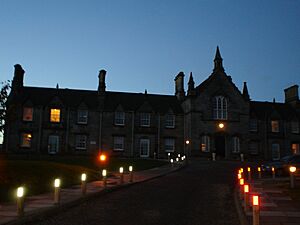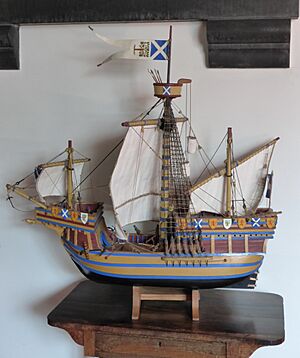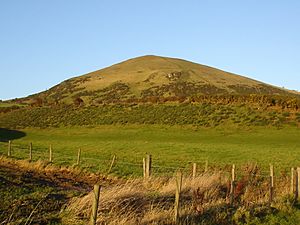Upper Largo facts for kids
Upper Largo or Kirkton of Largo is a small village in Fife, Scotland. It's located near the East Neuk area, sitting on the southern slopes of a hill called Largo Law. Just half a mile south is Largo Bay and the larger village of Lower Largo. Upper Largo is also home to the Largo Cricket Club.
Contents
Exploring Upper Largo
When you drive through Upper Largo, you might think it's just one street, which is called Main Street. This street has many shops and houses built from stone. In the middle of Main Street, there's a turn-off. If you go north-east, you'll head towards St Andrews on the A915 road. If you go east, you'll follow the coast on the A917.
At the west end of Main Street, you'll find the Upper Largo Hotel. There's also a shop that used to be a car garage and petrol station. From here, a small road goes north to a village green and the churchyard of the Largo and Newburn Parish Church. This churchyard is on a small hill, giving you great views over the village rooftops and the houses nearby.
Further east along Main Street, another small road goes south. This road has houses and offers amazing views over Largo Bay. You can even see across The Firth of Forth to Edinburgh! At the very eastern edge of the village, you'll find Buckthorns farm.
John Wood's Hospital: A Place of Help
On the road to St Andrews, you'll see a very old and important building called John Wood's Hospital. It was built a long time ago, in 1659 or 1665. It was a special home, like a shelter, for older men who had the same last name as the person who built it, John Wood. The building was updated in 1975 and is now used as sheltered housing, providing homes for people who need a bit of support.
Sir Andrew Wood: A Scottish Hero
Sir Andrew Wood was a famous Scottish naval hero, sometimes called the Scottish Nelson. He became well-known for winning battles against the English fleet around the year 1500. Because of his brave actions, the kings James III and James IV gave him land in this part of Fife.
Sir Andrew lived in a medieval house called Largo House. Today, only a tower of this old house remains, located about 300 yards west of the local church. The oldest part of the church you see today was built in 1623, but it was likely built on the site of an even older church. Sir Andrew was said to have built a canal connecting his house to the church. This is thought to be Scotland's earliest canal! He used it to be rowed to church in his own boat every Sunday, showing off his status as a naval hero.
Largo Law: A Volcanic Hill
Largo Law is a hill that stands about 290 meters (951 feet) tall. It has a cone shape because it's actually the remains of an old volcanic plug. This means it's what's left of a volcano's core after the softer rock around it has worn away.
You can easily climb Largo Law from Upper Largo. The path starts near a cemetery, where there's an information board and parking. The route goes past Chesterstone Farm before heading straight up the steep southern side of the hill.
East of the main summit, about 2 kilometers away, is a smaller hill called Flagstaff or Crescent Hill. On top of this hill, there's an ancient burial mound called a barrow.
Ancient Pictish Stone
Just inside the entrance to the churchyard of the Parish Church, you can see a special stone called a Class 2 Pictish Stone. On one side, it has a cross carved into it, along with mysterious Pictish symbols. On the other side, you'll find a hunting scene and more Pictish symbols, including a double disc and Z-rod, and a strange creature known as a Pictish beast. These stones give us clues about the ancient Pictish people who lived in Scotland long ago.
Images for kids






